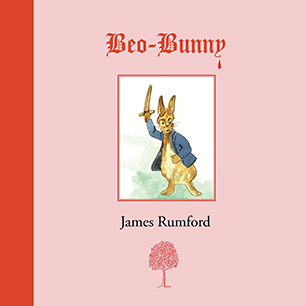Hwæt?!

To purchase a copy, click here.
I wrote þas lytele boc—this little book—to celebrate the publication of Beowulf, A Hero’s Tale Retold, which I wrote and illustrated back in 2007. I had intended to make only a few copies of Beobunny for friends, but now in the year 2012, with the ease of print-on-demand publishing, I decided to offer it to a wider audience. Wider? Well, as wide an audience as a book written in Old English can muster spoofing The Tale of Peter Rabbit.
What do the tales of Peter Rabbit and Beowulf have to do with each other? For one thing, both are very, very English. And for another both are very, very scary. I remember the first time I heard The Tale of Peter Rabbit. I was four. The neighbor kid had a vinyl recording of someone reading the story. When the story was over, I was horrified to think that, having totally identified with Peter Rabbit, I might find myself running for my life not from mean Mr. McGregor but from mean Mr. Wilcox, who lived two doors down. As for Beowulf, by the time I got around to reading it—fifty years later—I was brave enough not to be scared by the words but I could imagine how frightening this poem must have seemed to Anglo-Saxon ears centuries and centuries ago, how awful the bone-crunching consonants of our language must have sounded coming from the mouth of a wizened bard as he moved in and out of the light of the fire, as his listeners jumped with every fire-crack from the hearth.

But there is a third connection between the two tales. Both tales deal with facing fear. Beowulf, a real hero, of course, never backs down, and, in the end, he perishes. Peter Rabbit starts off fearless, and is ready to face ole Mr. McGregor, but in the end, being just a bunny, he runs back to the safety of his mother’s arms. I guess I wrote this book to give Peter Rabbit a bit more Beowulfian gumption. I didn’t want him running home to mama. So, I invented this story and illustrated it in the style of Beatrice Potter, hoping that any future reader might remember that imitation is the sincerest form of flattery.
I also decided to write the story in Anglo-Saxon, the ancestor of modern English. Just as I had used only words that could be traced back to Anglo-Saxon in my retelling of Beowulf, so I thought it would be fun to write a tale in the ancient language that people today could easily read. I suppose that a Merlin or King Arthur would raise an eyebrow at my childish constructions—for I simplified the word order—but I am sure that they would have been able to read the tale just as you can. Some of you might stumble over the endings of words, but, if you relax your mind just a bit, you’ll catch the meaning. Perhaps you might smile to yourself to think that you can understand thousand-year old words, words that have not been uttered for centuries.
Anglo-Saxon morphed into Chaucer’s English in the twelfth century. Then Chaucer’s English changed into Shakespeare’s English by the sixteenth century. Then his English became ours as the bard had to make room for modern writers. The final blow came when the King James Bible English of Shakespeare’s time was superseded by newer and newer translations so that a phrase such as ‘our Father who art’ becomes incomprehensible. How hath this happened? Through change and the passage of years that transforms the speech of our grandfathers into the talk of our grandchildren.
Of course, in the case of English, change could also be abrupt. In 1066, a French-speaker named William, who added Conquerer to his name—perhaps to impress upon the peasants his dominance—made his mother tongue la langue du jour. He and his nobles gave speaking French such class that pretty soon no one wanted to live in a house. They wanted to reside in manor. They didn’t sail by boat but traveled by vessel. They no longer ate cow meat but dined on beef. That was not sheep on the board but mutton on the table. And so on and so forth until eighty per cent of the vocabulary of our tongue became French/Latin. Not only that, but the grammar changed. All of those endings? Gone….well most of them anyway with hold-outs like the apostrophe s in ‘Mary’s house’ or the almost dead m in ‘whom.’ French almost took over, but it didn’t . . . or did it? Maybe our language is really a dialect of French. Now, wouldn’t that thought raise the hackles of some purists? I mean, with 80% of our vocabulary French/Latin and our grammar looking the least Germanic of all of the Germanic languages, some one might make this case—if that someone felt so inclined. Instead, I tried to prove the opposite by using only Anglo-Saxon words to tell my version of Beowulf and using real Anglo-Saxon to write this untold story of Peter Rabbit.

But before I get carried away barking up the wrong linguistic tree, or raising issues I ought not, I must mention the real reason I wrote þas lytele boc: to have fun. After years and years of writing and rewriting drafts for my retelling of Beowulf, after months of fretting over the illustrations, I needed an outlet. I wanted to poke fun at my own seriousness. I often do this. In fact, my book Don’t Touch My Hat!, published by Knopf in 2007, also came out of toiling over Beowulf. Before that, after finishing The Traveling Man, published by Houghton Mifflin in 2001, I wrote a spoof on traveling, which later became Calabash Cat, also published by Houghton Mifflin (2003). There are other such spoofs I have concocted. Maybe one day, I’ll publish a few more of them.

